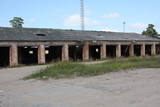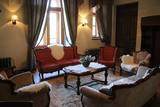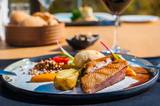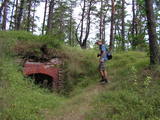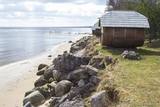| Nr | Nosaukums | Apraksts |
|---|---|---|
|
Latvijas lielākā parastā liepa (Tilia cordata). Daļa no varenajiem žuburiem ir atbalstīti. Stumbrā lieli dobumi, kas aizklāti, lai novērstu ūdens iekļūšanu un ātrāku trupēšanas procesu. Tāpat kā daudzi citi šāda izmēra koki – sena svētvieta.
|
||
|
Aptuveni 0,5 km dienvidos no Mežotnes pilskalna atrodas Vīna kalns, kas līdzīgi kā Mežotnes pilskalns, ir veidots, izmantojot Lielupes ielejas stāvās krastu nogāzes, tās pārveidojot. Vietvārds ir it kā radies no stāsta, ka šeit parādījies dievgalds ar maizi un vīnu. Vīna kalnu ar Mežotnes pilskalnu savieno jauka koka laipa, kas ved pa Lielupes ielejas pamatkrasta lejas daļu. |
||
|
Diplomēts mežsaimnieks Imants Urpens Alojas novada "Ošlejās" audzē šitaki sēnes. Šī ir arī mācību saimniecība, uz kuru brauc mācīties pārsvarā ārzemnieki. Saimniecība ir bioloģiski sertificēta. Pieņem ekskursijas un pasūtījumus sēņu audzēšanai un micēlija iegādei. |
||
|
Pēc Beverīnas amatnieku biedrības iniciatīvas atjaunotajā namiņā piedāvā gan novada, gan plašākas apkaimes amatnieku produkciju, radošās darbnīcas un pasākumus dažādu rokdarbu tehniku apguvē. Namiņš ir gan apmācību centrs, gan amatniecības izstrādājumu tirgotava, gan arī Beverīnas novada kultūras, folkloras un latviskās dzīvesziņas popularizēšanas centrs. |
||
|
Viesu nams "Ausmas" atrodas Valkas novadā, un tajā iespējams nakšņot līdz 30 cilvēkiem. Tiek piedāvāti arī ēdināšanas pakalpojumi gan uz vietas, gan izbraukumos. Viesiem pieejama slapjā pirts, kā arī pirts rituāls pie prasmīga pirtnieka. Viesu namā tiek organizēti dažādi pasākumi, tāpat tiek uzņemtas ekskursiju un bērnu grupas. Saimniecībā atrodas arī dzīvnieku sēta, kur bērni var pabarot un samīļot dažādus dzīvnieciņus. Saimnieki aktīvi sadarbojas ar blakus esošajām saimniecībām. Viesu nama saimnieki ir mājražotāji, kuri piedāvā viesiem nobaudīt dažādus kūpinājumus, sierus un pašceptu maizi. Tiek piedāvātas meistarklases gan siera siešanā, gan maizes cepšanā. Ir iespēja apmeklēt un sarīkot degustācijas gan ar pašu ražotiem produktiem, gan ar apkārtējo saimniecību piedāvājumu. |
||
|
Padomju gados Ventspils tanku daļā atradies mācību pulks. Mūsdienās objekts ir degradēts un apsaimniekotas tiek tikai bijušās tanku daļas remonta un saimnieciskās ēkas. Pārējā teritorija netiek izmantota. Iespējams, saglabājušies bijušie tanku remontlaukumi.
|
||
|
Parka „mugurkauls” ir Šventojas (Šventoji) upes (tulkojumā – Svētā upe) ieleja. Šventojas krastā ir apskatāms viens no Lietuvas iespaidīgākajiem Devona perioda smilšakmens atsegumiem - Vetygalos atodanga, bet Varius strauta krastos – kvarca smilšu atsegums - Variaus atodanga. 6 km dienvidos no Anykščiai atrodas otrs Lietuvas lielākais dižakmens (5,7 m augsts, ~ 100 m3) – Puntukas akmuo.
|
||
|
No 15. gs. Priekulē valdījusi baronu Korfu dzimta. Viens no viņiem - Johans Albrehts Korfs (1697. – 1766.) bijis Pēterburgas Zinātņu akadēmijas prezidents (1734. - 1740. g.), diplomāts un literāts, kas pētījis Kurzemes vēsturi. Priekules pils atrodas rietumos no Aizputes ielas, Virgas upītes ielejas krastā. Sākotnēji Priekules muižas pili cēla 18. gs., taču 19. gs. beigās notika lielāki ēkas pārbūves darbi, kuru projekta autors bija pazīstamais Liepājas arhitekts Pauls Makss Berči (1840. – 1911.). Mūsdienās ēkā atrodas Priekules vidusskola. Nepilnus 100 m austrumos no ēkas koku ieskāvumā slejas muižas skatu tornis (celts 19. gs. beigās), kurā plīvo Latvijas valsts karogs. |
||
|
Veidots 1900. gadā pie Pērses ietekas Daugavā (tagad – Pļaviņu HES ūdenskrātuvē) un tajā apskatāmi 17. gs. zviedru lielgabali un viduslaiku kapu pieminekļi. Parkā (pie vidusskolas) atrodas atjaunotā strūklaka „Fauna galva”, kas 20. gs. trīsdesmitajos gados atradās netālu no leģendārā Pērses ūdenskrituma (tagad zem ūdens), kura vietu upes krastā iezīmē akmens skulptūra „Pērses meitene” (autors: J. Zihmanis). Celiņš aizved gar tēlnieka Ģ. Burvja veidoto 11 m augsto koka skulptūru „Mūžībai” un koktēlnieku – brāļu Rūrānu veidoto „Pūcīti”. |
||
|
No brīnišķīgajā Võrumaa pakalnu ainavā augušajām ogām un augļiem saimnieki gatavo vīnu, iepazīstina ar savu dārzu, vīna gatavošanu, organizē degustācijas un apmācības. |
||
|
Pils tika būvēta tā, lai būtu gandrīz kopija Vindzoras pilij Anglijā. Šī ir viena no neierastākajām muižām Igaunijā. Tā ir tikpat interesanta kā tās īpašnieks - Frīdrihs fon Bergs. Aiz pils ir dendrārija parks ar reti sastopamām sugām. |
||
|
Restorāns atrodas skaistā vietā ar stāstu un nākotni - Amatciemā. "Jonathan" restorāns izmanto vietējos produktus no zemnieku saimniecībām, lai ēdienus pasniegtu mūsdienīgā interpretācijā, uzsvaru liekot uz garšu un kvalitāti. Ir daļa no Jonathan SPA Estate kompleksa, kurā ir viesnīca un SPA. |
||
|
Lina, vilnas apģērbu šūšana, galdautu, dvieļu, jostu u.c. tekstilizstrādājumu šūšana. Tērpu darināšana nav tikai darbs, bet arī aicinājums. Tas palīdz izgatavot vissarežģītākās tērpu konstrukcijas. Nemitīgā zināšanu papildināšana kursos ļauj veiksmīgi dzīvot līdzi mainīgajām modes prasībām. Paralēli individuālajiem pasūtījumiem tiek izgatavoti gan apģērbi, gan citi šūtie izstrādājumi tirdzniecībai. |
||
|
Forti celti un pārveidoti ilgākā laika posmā. To celšanā rokas pielikuši gan vācieši, gan zviedri, gan krievi. 20.gadsimta sākumā - 1912.gadā tika uzsākta vairāku fortu būve Mangaļsalā un Bolderājā. Tika uzcelti divi forti ar 254mm lielgabaliem, seši forti ar 152mm lielgabaliem un trīs forti ar 138mm. Katrā fortā tika uzstādīti divi lielgabali. Mangaļsalas fortifikāciju sistēma sastāv no vairākām daļām un atrodas samērā plašā teritorijā. Atsevišķas tās daļas ir arī nepieejamas, jo atrodas mazdārziņu teritorijā. Tas ir unikāls vēstures piemineklis, kas atrodas valsts galvaspilsētā, bet tajā pat laikā ir "aizmirsts", nesakopts, grūti pieejams un apmeklējumiem bīstams. Ja objekts tiktu attiecīgi novērtēts un apsaimniekots, - nākotnē tas varētu būt viens no Rīgas tūrisma "top" objektiem, jo Rīga nav tikai Vecrīga. |
||
|
Veidots Kuršu kāpas (lielākais kāpu veidojums Baltijas valstīs), piekrastes, biotopu, sugu, kultūrvēsturiskā mantojuma un kurortoloģisko resursu aizsardzībai. Vienīgā vieta Baltijā, kur tik lielā teritorijā var apskatīt klajus kāpu smiltājus, kas joprojām ir aktīvi un vēja ietekmē veido t.s. eolās reljefa formas. Te atrodas Baltijā vienīgais Jūras muzejs un Delfinārijs. |
||
|
Sens lībiešu ciems, ar lībisko nosaukumu Mustanumm. Vēl 20. gs. vidū šeit dzīvoja lībieši. Melnsilā pie Baķupītes ietekas Rīgas jūras līcī, Landmaņu, Moricu un Otomeru dzimtas pārstāvji uzbūvēja trīs buriniekus. Melnsilā atrodas divas kultūrvēsturiskas vietas: senā kulta vieta - Baķu baznīckalns un jūras laupītāja Tromeļa pilskalns. (Avots: Rojas TIC) |
||
|
Viens no savdabīgākajiem nacionālā parka dievnamiem, kas ar zvanu torni (celts no sarkanajiem ķieģeļiem) un tuvējām dzīvojamām ēkām veido interesantu kultūrainavas kompleksu. Apskatāms no ārpuses. |
||
|
Ģimenes uzņēmums Svētes pagastā, netālu no Jelgavas. Kopš 2019.gada šeit top dažādi Latvijas priežu produkti, kas vērtīgi kā imunitātei, tā arī veselībai. Mītavas Čiekurs produktu galvenā sastāvdaļa ir Parastā priede (Pinus sylvestris). Tā bagāta ar ēterisko eļļu, sveķiem, miecvielām, C vitamīnu u.c. vērtīgām vielām. Tiek gatavotas priežu čiekuru karameles, čiekuru sīrupa zefīri, želejkončas, priežu čiekuru zapte, karamelizēti čiekuri sīrupā, šokolādē, kā arī priežu pumpuru sīrups un tēja. Ekskursija norisinās 90-120 minūtes, kuru laikā atraktīvais saimnieks Reinis pastāstīs par uzņēmuma vēsturi, dalīsies receptēs, pagatavos katram apmeklētājam gardu dāvanu (čiekuru marmelādi), kā arī protams- varēs degustēst dažādos priežu produktus. Papildu pirms vai pēc ekskursijas iespējams ieturēties ar uz ugunskura gatavotu pupiņu zupu ar lauku kūpinājumiem, soļanku vai biešu zupu. Tūristus uzņem nupat uzbūvētajā ekskursiju telpā- Čiekurnīcā. Uzņemt var līdz pat 60 interesentiem reizē. |
||
|
Viesu namā var apskatīt viesu nama lepnumu – pagrabu –, kurā atrodas liela saimniecībā gatavoto vīnu kolekcija. Saimniecībā var iegādāties ābolu, vīnogu, ķiršu, upeņu, dzērveņu, ērkšķogu un rabarberu vīnu. |
||







